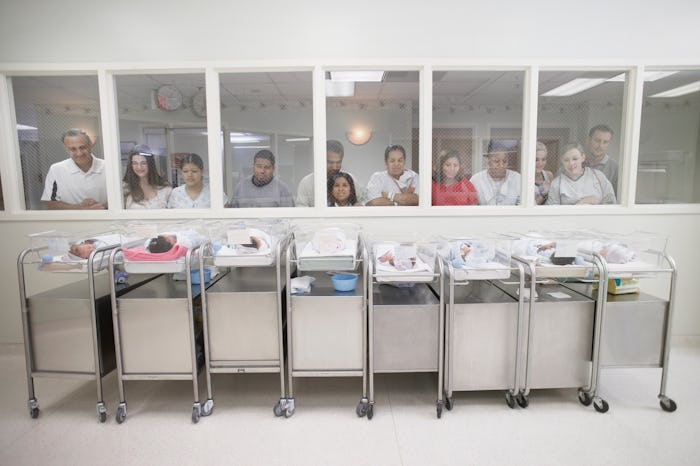Life

Will Coronavirus Quarantines Lead To A Baby Boom In 9 Months?
You may have heard of "hurricane babies" or "blizzard babies," but with COVID-19 causing a shutdown of the entire world, a coronavirus pandemic baby boom sounds absolutely legit. But has it ever happened before?
Per the Centers for Disease Control and Prevention (CDC), "Community-based interventions such as school dismissals, event cancellations, social distancing, and creating employee plans to work remotely can help slow the spread of COVID-19." Basically, if your community experiences multiple cases of coronavirus, the CDC wants you to stay home. Notably, hard-hit parts of the United States, many Asian countries, Italy, and other areas worldwide are already in lockdown mode.
So, what does one do when stuck at home all day? And what in the world does this have to do with babies?
"There are certainly tons of anecdotal reports of increased fecundity or fertility after events forcing people to stay at home," Dr. Michael Cackovick, M.D., a maternal fetal medicine physician at the Ohio State University Wexner Medical Center, tells Romper. "Scientific reports, however, have been mixed in an effort to confirm the phenomenon."
The baby boom, a phenomenon that occurs nine months after an event like a snowstorm or a hurricane causes people to hole up in their homes for long periods of time, is well-documented. In 2013, CBS News reported that multiple East Coast hospitals saw an increase in babies born nine months after Superstorm Sandy. By the same token, a massive New England snowstorm in 1978 is reported to have led to an increase of births nine months later, according to The Boston Globe.
Cackovic tells Romper that reasons for this "include the human response to loss, disruption in access to family planning and of course, increased sexual activity from being confined to home."
Nine months after Hurricane Harvey ravaged the Texas coast in 2017, local hospitals saw an increase in the number of babies born, but it wasn't just extra time holed up together that led to more babies. Houston mom Brooke Rodriquez's daughter was conceived days after the storm after she and her husband cleaned up their flooded home.
"People really come together after natural disasters — marriages included," Rodriquez tells Romper. "I feel like we needed each other's support far more, so in turn we were definitely more connected emotionally than any other normal time."
It stands to reason that the same type of birth rate spike could happen following coronavirus quarantines, but there are some gray areas. Following the 1918 to 1919 influenza pandemic (often called the Spanish Flu due to its origins in Spain), Norway did see a huge baby boom in 1920. Research says the Spanish Flu, coupled with separation of soldiers from their families during the war, was responsible for a decrease in babies born from 1914-1919, and the subsequent baby boom in 1919-1920 following the end of World War I in 1918 has been studied by researchers in several countries including Denmark, Sweden, Norway, and the U.S.
It makes sense that soldiers returning home could cause a baby boom, but research published in the Journal of Infectious Disease in 2011 hypothesized that the post-pandemic baby boom Norway saw in 1920 was partially also a response to early pregnancy loss during the pandemic (infected women miscarried more often than expected). Essentially, women were finally healthy and able to carry their babies to term after the end of the pandemic, which isn't something that's happening with COVID-19. "Older people and people of all ages with severe underlying health conditions — like heart disease, lung disease, and diabetes, for example — seem to be at higher risk of developing serious COVID-19 illness," the CDC reported.
So thanks to modern medicine and technology, if a post-coronavirus baby boom does occur, it will likely not follow the pattern of the post-Spanish Flu boom and might be more closely related to the birth rate increases following natural events like snowstorms and hurricanes. Like Cackovic says, these types of situations can promote closeness because of the human response to loss, and it's backed by science. A 2012 study published in Psychological Science found that while fight-or-flight is the typical behavioral and physiological response to stress, a person's reaction often follows a "tend-and-befriend" strategy, where stress triggers a social approach behavior. Because of this, a stressful event has the potential to bring people together, corroborating Rodriquez's theory that a disaster makes you feel closer with those around you.
The jury is still out on whether or not a post-pandemic baby boom will occur thanks to coronavirus quarantines, but in about nine months, you should be able to tell whether or not this theory holds true.
If you think you’re showing symptoms of coronavirus, which include fever, shortness of breath, and cough, call your doctor before going to get tested. If you’re anxious about the virus’s spread in your community, visit the CDC for up-to-date information and resources, or seek out mental health support. You can find all of Romper’s parents + coronavirus coverage here, and Bustle’s constantly updated, general “what to know about coronavirus” here.
Experts:
Dr. Michael Cackovic, M.D., maternal fetal medicine physician at The Ohio State University Wexner Medical Center
Studies Referenced:
Svenn-Erik. (2012, April 25). Fertility Fluctuations in Times of War and Pandemic Influenza. Retrieved from https://academic.oup.com/jid/article/206/1/140/835453
Kimberly, Miller, A., M., Magnus, Andreasen, Viggo, & Simonsen. (2011, October 15). Natality Decline and Miscarriages Associated With the 1918 Influenza Pandemic: The Scandinavian and United States Experiences. Retrieved from https://academic.oup.com/jid/article/204/8/1157/816427
Mamelund, S.-E. (2004). Can the Spanish Influenza Pandemic of 1918 Explain the Baby Boom of 1920 in Neutral Norway? Population (English Edition, 2002-), 59(2), 229. doi: 10.2307/3654904
von Dawans B, Fischbacher U, Kirschbaum C, Fehr E, Heinrichs M. (2012). The social dimension of stress reactivity: acute stress increases prosocial behavior in humans. https://www.ncbi.nlm.nih.gov/pubmed/22593119
This article was originally published on